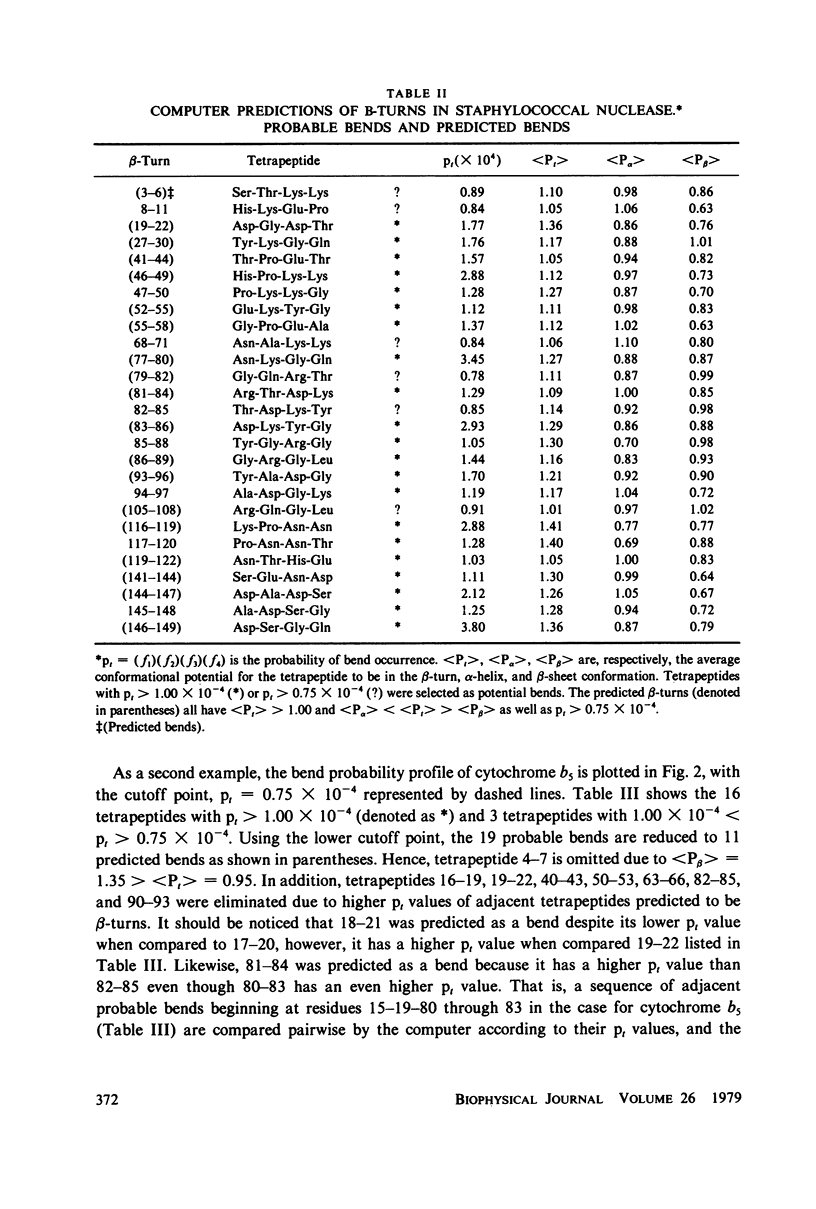Abstract
An automated computer prediction of the chain reversal regions of globular proteins is described herein using bend frequencies and beta-turn conformational parameters (Pt) determined from 408 beta-turns in 29 proteins calculated from x-ray atomic coordinates. The probability of bend occurrence at residue i is pt = fi X fi+1 X fi+2 X fi+3 with the average bend probability less than Pt greater than = 0.55 X 10(-4). Tetrapeptides with pt greater than 0.75 X 10(-4) ( approximately to 1.5 X less than pt greater than) as well as less than Pt greater than 1.00 and less than Pa greater than less than less than Pt greater than greater than less than P beta greater than are selected by the computer as probable bends. Adjacent probable bends (i.e., 11-14, 12-15, 13-16) are compared pairwise by the computer, and the tetrapeptide with the higher pt value is predicted as a beta-turn. The percentage of bend and nonbend residues predicted correctly for 29 proteins by this computer algorithm is %t+nt = 70%, whereas 78% of the beta-turns were localized correctly within +/- 2 residues. The average beta-turn content in the 29 proteins is 32%, with helical proteins having fewer bends (17%) than beta-sheet proteins (41%). Three proteins having iron-sulfur clusters were found with the highest percentages of beta-turns: Chromatium high potential iron protein (65%), ferredoxin (57%), and rubredoxin (65%). Finally, the bend frequencies at all 12 positions from 457 beta-turns in 29 proteins (Chou and Fasman, 1977) were used to test the effectiveness of predicting bends using 2, 4, 8, and 12 residues as well as different cut-off pt values. The computer analysis showed that 1.25 less than pt greater than to be the best cut-off yielding 70% accuracy in %t+nt for 4 residues and %t+nt = 73% for 12 residues in predicting the bend and nonbend regions of proteins.
Full text
PDF
















Selected References
These references are in PubMed. This may not be the complete list of references from this article.
- Argos P., Schwarz J., Schwarz J. An assessment of protein secondary structure prediction methods based on amino acid sequence. Biochim Biophys Acta. 1976 Aug 9;439(2):261–273. doi: 10.1016/0005-2795(76)90062-3. [DOI] [PubMed] [Google Scholar]
- Carter C. W., Jr, Kraut J., Freer S. T., Nguyen-Huu-Xuong, Alden R. A., Bartsch R. G. Two-Angstrom crystal structure of oxidized Chromatium high potential iron protein. J Biol Chem. 1974 Jul 10;249(13):4212–4225. [PubMed] [Google Scholar]
- Chou P. Y., Adler A. J., Fasman G. D. Conformational prediction and circular dichroism studies on the lac repressor. J Mol Biol. 1975 Jul 25;96(1):29–45. doi: 10.1016/0022-2836(75)90180-1. [DOI] [PubMed] [Google Scholar]
- Chou P. Y., Fasman G. D. Beta-turns in proteins. J Mol Biol. 1977 Sep 15;115(2):135–175. doi: 10.1016/0022-2836(77)90094-8. [DOI] [PubMed] [Google Scholar]
- Chou P. Y., Fasman G. D. Prediction of protein conformation. Biochemistry. 1974 Jan 15;13(2):222–245. doi: 10.1021/bi00699a002. [DOI] [PubMed] [Google Scholar]
- Chou P. Y., Fasman G. D. Prediction of the secondary structure of proteins from their amino acid sequence. Adv Enzymol Relat Areas Mol Biol. 1978;47:45–148. doi: 10.1002/9780470122921.ch2. [DOI] [PubMed] [Google Scholar]
- Crawford J. L., Lipscomb W. N., Schellman C. G. The reverse turn as a polypeptide conformation in globular proteins. Proc Natl Acad Sci U S A. 1973 Feb;70(2):538–542. doi: 10.1073/pnas.70.2.538. [DOI] [PMC free article] [PubMed] [Google Scholar]
- Dickerson R. E., Takano T., Eisenberg D., Kallai O. B., Samson L., Cooper A., Margoliash E. Ferricytochrome c. I. General features of the horse and bonito proteins at 2.8 A resolution. J Biol Chem. 1971 Mar 10;246(5):1511–1535. [PubMed] [Google Scholar]
- Fasman G. D., Chou P. Y., Adler A. J. Prediction of the conformation of the histones. Biophys J. 1976 Oct;16(10):1201–1238. doi: 10.1016/S0006-3495(76)85768-2. [DOI] [PMC free article] [PubMed] [Google Scholar]
- Kuntz I. D. Protein folding. J Am Chem Soc. 1972 May 31;94(11):4009–4012. doi: 10.1021/ja00766a060. [DOI] [PubMed] [Google Scholar]
- Lenstra J. A. Evaluation of secondary structure predictions in proteins. Biochim Biophys Acta. 1977 Mar 28;491(1):333–338. doi: 10.1016/0005-2795(77)90070-8. [DOI] [PubMed] [Google Scholar]
- Lewis P. N., Momany F. A., Scheraga H. A. Chain reversals in proteins. Biochim Biophys Acta. 1973 Apr 20;303(2):211–229. doi: 10.1016/0005-2795(73)90350-4. [DOI] [PubMed] [Google Scholar]
- Lewis P. N., Momany F. A., Scheraga H. A. Folding of polypeptide chains in proteins: a proposed mechanism for folding. Proc Natl Acad Sci U S A. 1971 Sep;68(9):2293–2297. doi: 10.1073/pnas.68.9.2293. [DOI] [PMC free article] [PubMed] [Google Scholar]
- Mathews F. S., Levine M., Argos P. Three-dimensional Fourier synthesis of calf liver cytochrome b 5 at 2-8 A resolution. J Mol Biol. 1972 Mar 14;64(2):449–464. doi: 10.1016/0022-2836(72)90510-4. [DOI] [PubMed] [Google Scholar]
- Matthews B. W. Comparison of the predicted and observed secondary structure of T4 phage lysozyme. Biochim Biophys Acta. 1975 Oct 20;405(2):442–451. doi: 10.1016/0005-2795(75)90109-9. [DOI] [PubMed] [Google Scholar]
- Robson B., Pain R. H. Analysis of the code relating sequence to conformation in globular proteins. The distribution of residue pairs in turns and kinks in the backbone chain. Biochem J. 1974 Sep;141(3):899–904. doi: 10.1042/bj1410899. [DOI] [PMC free article] [PubMed] [Google Scholar]
- Schulz G. E., Barry C. D., Friedman J., Chou P. Y., Fasman G. D., Finkelstein A. V., Lim V. I., Pititsyn O. B., Kabat E. A., Wu T. T. Comparison of predicted and experimentally determined secondary structure of adenyl kinase. Nature. 1974 Jul 12;250(462):140–142. doi: 10.1038/250140a0. [DOI] [PubMed] [Google Scholar]
- Tanaka S., Scheraga H. A. Statistical mechanical treatment of protein conformation. 4. A four-state model for specific-sequence copolymers of amino acids. Macromolecules. 1976 Sep-Oct;9(5):812–833. doi: 10.1021/ma60053a024. [DOI] [PubMed] [Google Scholar]


